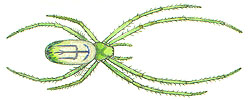 |
|
| You Are Here: Burke Museum : Spider Myths : I.D. : Must Be New |
Myths about Identifying Spiders
Myth: "I found a spider I'd never seen before. Since I can't tell what kind it is, it must be new to the area and probably dangerous to my children."
Fact: I hear this, or something like it, so very
often, and it makes so very little sense! A person who normally pays little
attention to spiders may have consciously noticed fewer than ten species. Any
temperate-zone region is likely home to several hundred species of spider. So
any given specimen stands a favorable chance of being new to you, without being
new to the area!
Again, spider identification is a highly technical skill,
requiring years of concentrated study to learn. And even skilled arachnologists
find it very difficult to identify spider species without the aid of a microscope.
So if you can't identify your specimen, that's no cause for surprise.
And again, the number of spiders that pose even a mild hazard to humans is vanishingly
small (perhaps 1/20 of 1% of all species) and, unsurprisingly, those few species
are far more widely publicized than the harmless majority. So that specimen
you found that is unfamiliar to you is therefore almost certainly nothing
to worry about!
Myth: One specimen is enough of a sample to tell what spiders live in a house.
Fact: The underlying assumption is that "my house couldn't possibly have more than one kind of spider...and even one is too many!" In reality, a typical human dwelling may also be home to 10-30 different spider species. One specimen isn't going to tell you much.
| Previous Myth | Myths Home | Web Resources | Next Myth |
 |
Text ©
2003, Burke Museum of Natural History & Culture, University of Washington, Box 353010, Seattle, WA 98195, USA Phone: 206-543-5590 Photos © as credited |
Queries
to Spider Myths author, Rod Crawford This page last updated 2 September, 2010 This site best viewed at 800 x 600 using IE 5.0 or above. |